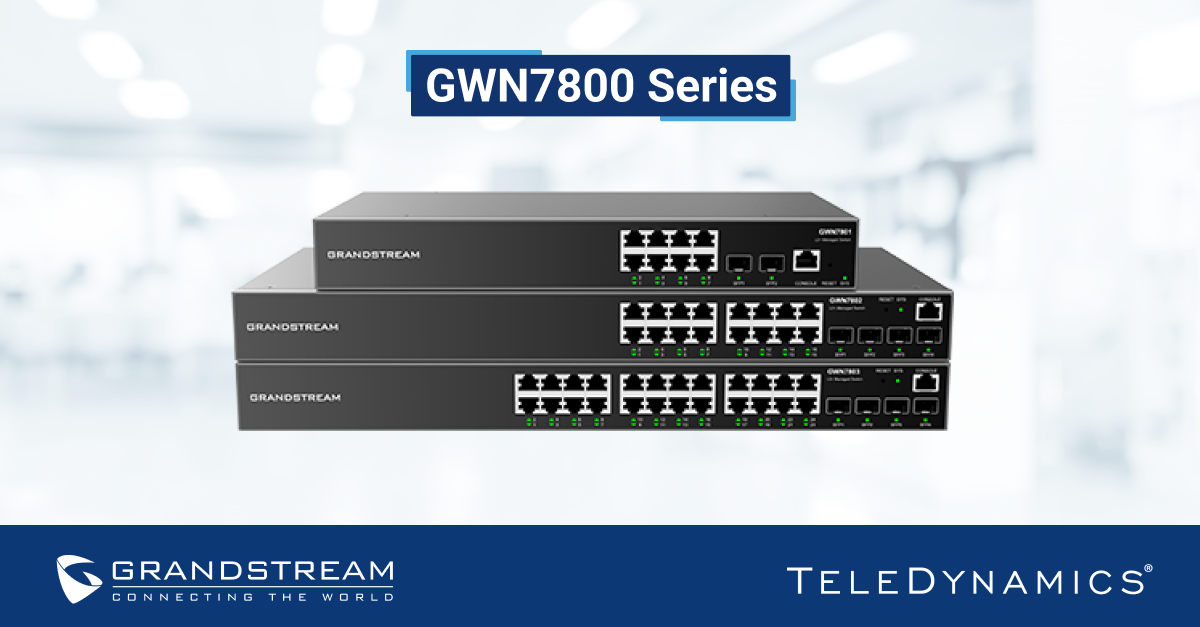Product Review
Grandstream is well known for its groundbreaking IP phones, but its innovation extends into other areas, including network infrastructure equipment and components. The new GWN7800 series of fully managed network switches is a prime example of the company’s leadership in this area.
This article showcases these switches and some advanced capabilities that allow network administrators to maintain comprehensive network control and security.
Read More
Topics:
SIP Phones,
IP PBX,
Grandstream,
Network Design,
Cloud,
Wi-Fi,
Switches
In previous articles, we've discussed the high reliability of VoIP technology. That said, achieving high reliability is only possible when built into the design of the VoIP network and the underlying network infrastructure supporting the service. One of the fundamental requirements to ensure such reliability is the implementation of VoIP failover. Here's what you need to know.
Read More
Topics:
VoIP,
SIP,
Business Continuity,
Mobile,
Network Design,
Cloud,
SD-WAN,
Unified Communications,
WAN Technology
Information and Communications Technology (ICT) often comprises a substantial portion of the budget for many businesses, a large part of which goes to paying the wages of support staff. Larger enterprises may need to employ a full-time, in-house team of professionals to support all their ICT services and assets, including VoIP communications systems.
However, smaller businesses have limited budgets and few ICT-related tasks to justify a full-time or even a part-time ICT position. It’s more difficult for these firms to support their communications systems without wasting valuable and often scarce resources.
In this article, we hope to provide you with insight on how to design the best support structure for your VoIP communications services without overextending your budget.
Read More
Topics:
VoIP,
Network Design,
Cloud,
Business Strategy
Product Review
Yealink’s MP series IP phones deliver a broad spectrum of capabilities for a wide array of uses. From a feature-rich, entry-level phone to a high call-volume, executive-level device, these IP phones deliver virtually all the telephony features that most businesses need today. In this article, we take a closer look at what Yealink’s MP series phones have to offer.
Read More
Topics:
SIP Phones,
Business Telephone System,
Yealink,
Videoconferencing,
Conferencing,
Network Design,
Product Review,
Microsoft,
Zoom
The concept of the “edge” is important when it comes to networking and telecommunications. There are two concepts in particular that use this terminology: the network edge and edge computing. These are distinct and separate constructs, but they are not entirely unrelated.
In this article, we’ll look at both and see how they differ and how they are interrelated.
Read More
Topics:
Trends,
Mobile,
Network Design,
Cloud,
SD-WAN,
WAN Technology
Telecommunications is a fast-paced field that changes constantly. It is more than a full-time job just keeping up with all of the emerging innovations that affect this industry. One of the fascinating aspects of this evolution is the fact that telecom relies heavily on companion technologies, emerging practices, and new methodologies that enable novel applications with seemingly science-fictionesque capabilities and functionality.
In this article, we talk about some of the most important technologies and methodologies that are changing the telecom landscape and which are expected to continue to do so in the coming years.
Read More
Topics:
Wireless,
VoIP,
Software Integration,
Trends,
Mobility (including remote work),
Mobile,
Network Design,
Cloud,
Wi-Fi,
IoT
A software-defined wide area network (SD-WAN) is a concept that has been around for over a decade. Even so, there are still many areas of this technology that are difficult to fully understand, especially for administrators and decision-makers whose expertise lies elsewhere. However, it is important for people in management positions to be aware of the benefits of SD-WANs because they are becoming increasingly essential as cloud-based services become more ubiquitous.
In this article, we shed light on SD-WANs and their usefulness in modern networks.
Read More
Topics:
Wireless,
Network Design,
Cloud,
SD-WAN,
WAN Technology
A WAN connection using wireless technology is among the simplest and fastest ways to connect a business to the internet. However, with so many technologies out there, and so many network design and architectural options to deploy, this simple solution can quickly take on a very complex form.
In this article, we hope to simplify the task of sorting through the various choices, allowing you to take advantage of quick, efficient, and often economical wireless options.
Read More
Topics:
QoS,
VoIP,
Network Design,
Wi-Fi,
WAN Technology
Wireless Internet Service Providers (WISPs) play an integral role in delivering internet connectivity to areas where wired connectivity is not economically viable. Rural, remote, and mountainous regions are the primary areas where WISPs thrive. In many cases, WISPs are the only option for connectivity, making them a vital component of a nation’s telecom infrastructure.
There are many technologies that help support the services provided by WISPs. One that is being leveraged more and more in recent years is Multiprotocol Label Switching (MPLS). This topic received considerable airtime at WISPAMERICA this year.
Read More
Topics:
Trends,
Network Design,
WAN Technology,
WISP
While certain live events have been cancelled amidst the COVID-19 pandemic, many of them have been replaced with virtual counterparts that have taken place via videoconference. Some of these events have had hundreds or even thousands of participants. With such numbers, how do videoconferencing systems cope with the traffic load and processing power required?
In this article, we take a look at the concepts involved with the scaling of videoconferencing for large numbers of participants. We also examine some best practices to keep in mind that will help ensure the quality of the end user experience.
Read More
Topics:
Total Voice Solution,
Yealink,
Videoconferencing,
Network Design

















